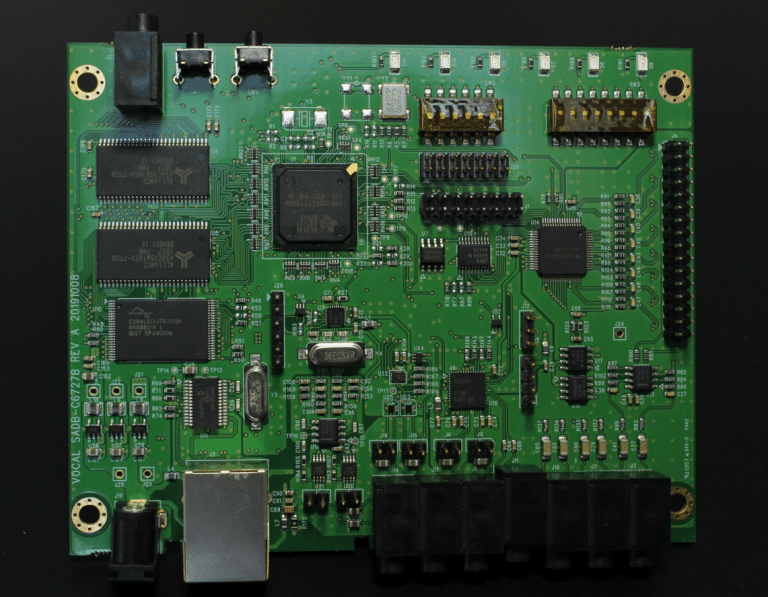Space Application Development Board
The Space Application Development Board (SADB-C6727B) enables developers to implement systems using standard and custom algorithms on processor hardware similar to what would be deployed for spacecraft in a fully radiation hardened (rad-hard) design. The SADB-C6727B is devised to be similar to a space qualified rad-hardened system design using the TI SMV320C6727B-SP DSP and high-rel memories (SRAM, SDRAM, NOR FLASH) from Cobham. The VOCAL SADB-C6727B development board does not use these high reliability space qualified components but rather implements various common bus widths and memory types/speeds for algorithm development and performance evaluation. Other related processors include the SMJ320C6701-SP – military spec 98661.

Audio inputs are handled by a TI ADS1278 high speed multichannel analog-to-digital converter (ADC) which has a variant qualified for space operation. Audio outputs may be generated from digital signal Pulse Density Modulation (PDM) or Pulse Width Modulation (PWM) signals to avoid the need for a space qualified digital-to-analog converter (DAC) hardware or a traditional audio codec circuit. A commercial grade AIC3106 audio codec is provided for algorithm development and for comparison of audio performance to PDM/PWM generated audio signals. Digital microphones (PDM or I2S formats) can be sampled by the processor directly or by the AIC3106 audio codec (PDM format only). Digital audio inputs/outputs can also be connected to other processors (using the McASP signals directly).
Both SRAM and SDRAM memories are supported via configuration resistors to allow for developing and benchmarking algorithms using either 16-bit wide or 32-bit wide busses (also via configuration resistors). Similarly the parallel NOR flash can operate with either 8-bit or 16- bits busses. Large SDRAM can be easily accessed while the high address bits of SRAM and FLASH are page addressed via processor GPIO signals. Both the parallel NOR flash and an I2C EEPROM may be used a processor boot devices.
The Ethernet MAC/PHY connects via SPI and is used to simulate off-processor communications. This is not likely to be directly used in space environments but can be used to approximate an Ethernet/IP based communications network. A serial UART connected via I2C is used for diagnostic/development purposes. JTAG is also supported but generally is insufficient for monitoring a real-time running system which is why UART serial data is supported.
The Ethernet MAC/PHY connects via SPI and is used to simulate off-processor communications. This is not likely to be directly used in space environments but can be used to approximate an Ethernet/IP based communications network. A serial UART connected via I2C is used for diagnostic/development purposes. JTAG is also supported but generally is insufficient for monitoring a real-time running system which is why UART serial data is supported.

SIPv2 – Session Initiation Protocol (RFC 3261, 3262, 3263, 3264)
SDP – Session Description Protocol (RFC 4566)
RTP – Real-Time Protocol (RFC 3550, 3551)
RTCP – Real-Time Control Protocol (RFC 3550)
RFC 4733 X-NSE Tone Events for SIP/RTP
RFC 4733 AVT Tone Events for SIP/RTP
STUN – Simple Traversal of UDP over NATs (RFC 3789)
SIPS – SIP Secure using TLS (RFC 3261)
SRTP – Secure Real-time Transport Protocol (RFC 3711, 4568)
MKI – Master Key Identifier (part of RFC 3711)
AES – Advanced Encryption Standard – supports 128/195/256 bit keys
HMAC – Authentication
IPv4 – Internet Protocol Version 4 (RFC 791)
TCP – Transmission Control Protocol (RFC 793)
UDP – User Datagram Protocol (RFC 768)
ICMP – Internet Control Message Protocol (RFC 792)
RARP – Reverse Address Resolution Protocol (RFC 903)
ARP – Address Resolution Protocol (RFC 826)
DNS- Domain Name Server
DHCP Client – Dynamic Host Control Protocol (RFC 2131)
NTP – Network Time Protocol (RFC 1305)
SNTP – Simple Network Time Protocol (RFC 2030)
HTTP – HyperText Transfer Protocol
TFTP – Trivial File Transfer Protocol (RFC 1350)
PPPoE – Point to Point Protocol over Ethernet (RFC 2516)
G.711 – Pulse Code Modulation
G.722 – Wideband ADPCM
G.722.1 – 24k and 32k bps 7kHz Wideband
G.722.2 – GSM-AMR-WB
G.723.1 – 6.4 and 5.3 kbps ACELP/MP-MLQ
G.726 – 16, 24, 32 and 40 kbps ADPCM
G.728 – 16 kbps LD-CELP
G.729 – 8 kbps CS-ACELP
G.729A – 8 kbps CS-ACELP Low Complexity
G.729B – Silence Detection/Comfort Noise Generation
G.729D – 6.4 kbps CS-ACELP
G.729E – 11.8 kbps CS-ACELP
GSM-FR – GSM 06.10 Full Rate Vocoder
GSM-AMR NB – GSM 06.90 Adaptive Multi-Rate
GSM-AMR WB – Wideband Adaptive Multi-Rate
iLBC – Internet Low Bitrate Codec
OPUS – 16KHz SILK, 22/24KHz CELT
Speex – 8 kbps CELP
MELPe – 2400/1200/600 bps Codec
TSVCIS – Tactical Secure Voice (Wideband MELPe)
LPC10 and CVSD – Legacy Voice Codecs
Q.24 DTMF Generation with Zero Crossing Cutoff
Q.24 DTMF Detection exceeding Bellcore Specifications
Configurable Tone Generation for 4 Sets of Frequencies and 4 Sets of On/Off Cadence
Programmable Precise Tone Detectors
G.168 Line Echo Cancellation
16/32/64 ms Echo Length
Nonlinear Echo Suppression (ERL greater than 28 dB for f = 300 to 3400 Hz)
Double-Talk Detection
Full Duplex Speakerphone
Narrow and Wideband Operation (8Khz and 16KHz)
Adjustable Tail Length (128 ms typical, 256 ms max)
Nonlinear Echo Processing with Comfort Noise Generation
Full Duplex Operation with Noise Reduction
Double-Talk detection, Low Divergence during Double Talk
Dual/Multi-Microphone Adaptive Noise Cancellation
Single Channel Noise Reduction
Active Noise Cancellation to identify and remove repetitive noise signals
Frequency Domain Noise Reduction
18dB Noise Reduction (typical)
Approximate 20msec Delay
Audio Beamforming (four or more mics)
Audio Null Forming
Direction of Arrival Estimation
Audio Beam Steering
Automatic Gain Control
Voice Compressor
Multiband Equalizer
Automatic Delay Estimation
Battle Field VOX
Voice Activity Detection
Noise Gating
Wind Noise Reduction
Click Noise Removal
VAD/DTX/CNG as per SCIP 210 Appendix B